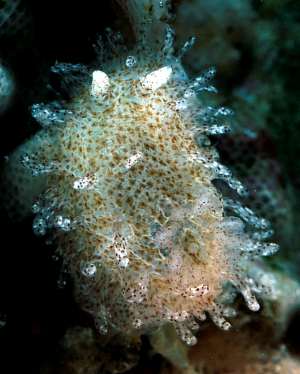

Okenia pilosa
(Bouchet and Ortea, 1983)
Order: NUDIBRANCHIA
Suborder: DORIDINA
Superfamily: ANADORIDOIDEA
Family: Goniodorididae
DISTRIBUTION
Known from New Caledonia, China (Hong Kong), Papua New Guinea and north-eastern Australia (Heron Is.).
PHOTO
Upper: Gau Tau (N), Mirs Bay, 5-12 m, Hong Kong, April 1983, AM C139137. Photo: B.W. Darvell. Lower: SEM of radula showing two large inner lateral teeth and two outer laterals, on the right side (A) and a close-up of two outer lateral teeth (B). A, Tai Tam Harbour, Hong Kong , 24 February 1984, 0.5 m, AM C141494. Photo: G. Avern. B, Kiu Tsui Chan, Port Shelter, Hong Kong, 4–7 m, February 1984, AM C141495. Photo: A.C. Miller. Scale bars = 10 µm.
NOTE: Previously known on the Forum as Hopkinsia pilosa.
The animal is round and flattened with many finger-like mantle papillae arranged in a series of irregular rows around the sides of the body. There can also be a few papillae in the central part of the mantle, including one on the outside of each rhinophore, another on each side of the gills, and 3 papillae arranged in a transverse row across the dorsum midway between the gills and the rhinophores. The rhinophores and gills are somewhat elongate, looking much like the papillae. There are about 12 gills arranged in a circle around the anus. From above there is no way to distinguish the mantle, foot and head, but ventrally, there is a transverse groove showing where the head and the foot join. There are no oral tentacles.
The body is translucent white with a close speckling of brown and an irregular network of white lines. The brown markings usually consist of a pale brown patch with a central dark brown spot. The mantle papillae are transparent with dark brown specks and some opaque white spots or streaks. The rhinophores and gills are similarly coloured.
The radular teeth are very similar in shape to those of O. plana. The innermost tooth has a broad base and a long elongate pointed cusp, with no sign of denticles along the cutting edge. The much smaller outer teeth have a broad quadrangular base with a large recurved pointed cusp at the tip, below which are 2 or 3 smaller secondary cusps, and then a basal cusp similar in size to the uppermost. However the shape of the denticulation of the outer teeth appears to vary with age (Rudman, 2004).
Like Okenia plana, the colour of the body and its round flattened body make it very well camouflaged on its bryozoan food. Okenia pilosa differs from O. plana in having many more of the finger-like lateral papillae. The animals are about 10 mm long and feed on encrusting bryozoan colonies on which they are found. Bouchet & Ortea, (1983) report this species feeding on an encrusting bryozoan, Calpensia sp. Originally placed in the genus Hopkinsia, a recent review (Gosliner, 2004) can find no grounds for keeping that genus distinct from the earlier Okenia.
-
Bouchet, P. & Ortea, J. (1983). A new Hopkinsia feeding on Bryozoa in the South Pacific (Mollusca: Opisthobranchia). Venus 42(3): 227-233.
-
Gosliner, T. M. (2004) Phylogenetic Systematics of Okenia, Sakishimaia, Hopkinsiella and Hopkinsia (Nudibranchia: Goniodorididae) with descriptions of new species from the tropical Indo-Pacific. Proceedings of the California Academy of Sciences, 55: 125-161.
-
Marshall, J.G. & Willan, R.C. (1999) Nudibranchs of Heron Island, Great Barrier Reef. A survey of the Opisthobranchia (Sea Slugs) of Heron and Wistari Reefs. Backhuys Publishers, Leiden, 257 pp.
-
Rudman, W.B. & Darvell, B.W. (1990) Opisthobranch molluscs of Hong Kong. Part 1. Goniodorididae, Onchidorididae, Triophidae, Gymnodorididae, Chromodorididae, (Nudibranchia). Asian Marine Biology, 7: 31-79
-
Rudman, W.B. (2004) Further species of the opisthobranch genus Okenia (Nudibranchia: Goniodorididae) from the Indo-West Pacific. Zootaxa, 695: 1-70.
ARCHIVE NOTE: An earlier edition of this Fact Sheet [5 July 2001] as Hopkinsia pilosa is available on request.
Authorship detailsRudman, W.B., 2004 (December 21) Okenia pilosa (Bouchet and Ortea, 1983). [In] Sea Slug Forum. Australian Museum, Sydney. Available from http://www.seaslugforum.net/factsheet/hopkpilo
Related messages
-
Okenia pilosa from Ratnagiri, India
From: Vishal Bhave, November 5, 2009 -
Hopkinsia pilosa from Hong Kong
From: Bill Rudman & Brian Darvell, February 4, 2002
